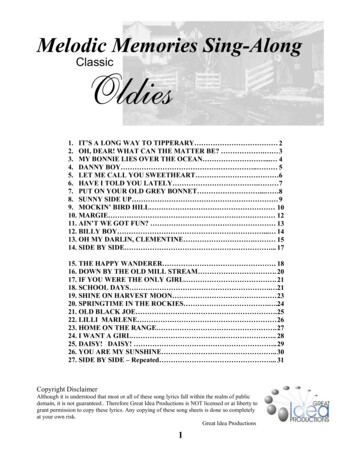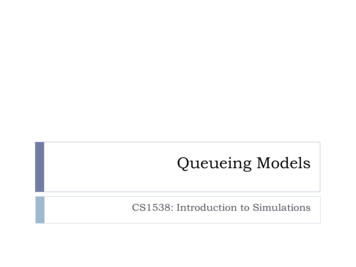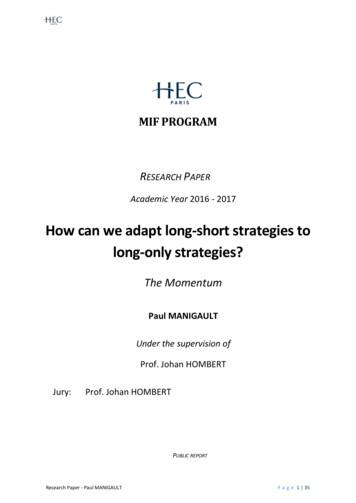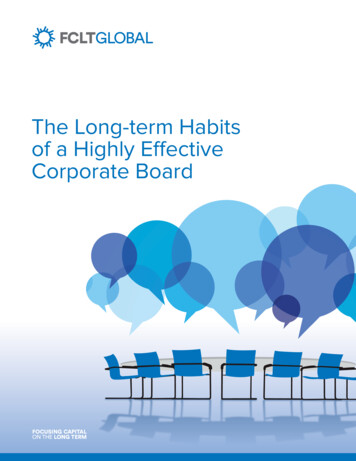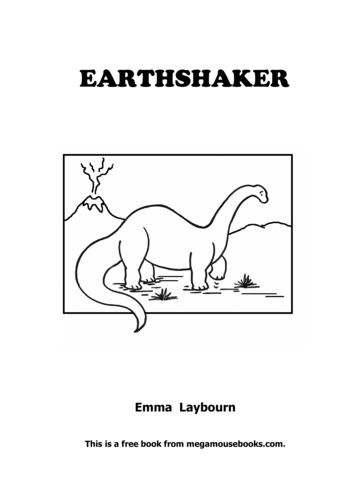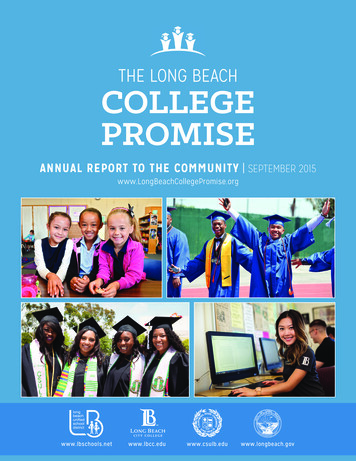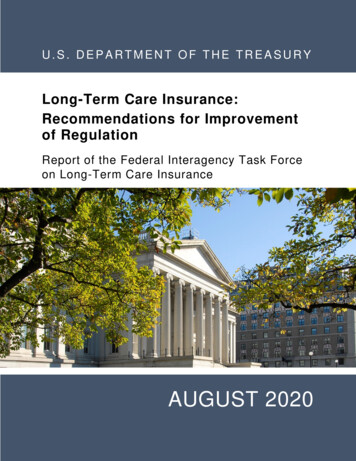
Transcription
Journal of Cardiovascular Translational Research (2021) 0133-9ORIGINAL ARTICLELong-Term Results of Hybrid Left Ventricular Reconstructionin the Treatment of Ischemic CardiomyopathyJan Naar 1 & Ivo Skalský 2 & Andreas Krűger 1 & Filip Málek 1 & Kevin Van Bladel 3 & Lon S. Annest 3 & Petr Moučka 1 &Tomáš Mráz 1 & Vivek Y. Reddy 4 & Petr Neužil 1Received: 14 March 2021 / Accepted: 26 April 2021 / Published online: 11 May 2021# The Author(s) 2021AbstractThe evidence supporting surgical aneurysmectomy in ischemic heart failure is inconsistent. The aim of the study was to describelong-term effect of minimally invasive hybrid transcatheter and minithoracotomy left ventricular (LV) reconstruction in patientswith ischemic cardiomyopathy. Twenty-three subjects with transmural anterior wall scarring, LV ejection fraction 15–45%, andNew York Heart Association class II were intervened using Revivent TC anchoring system. LV end-systolic volume index wasreduced from 73.2 27 ml at baseline to 51.5 22 ml after 6 months (p 0.001), 49.9 20 ml after 2 years (p 0.001), and 56.1 16 ml after 5 years (p 0.047). NYHA class improved significantly at 5 years compared to baseline. Six-min walk test distanceincreased at 2 years compared to the 6-month visit. Hybrid LV reconstruction using the anchoring system provides significantand durable LV volume reduction during 5-year follow-up in preselected patients with ischemic heart failure.Keywords Hybrid approach . Ischemic cardiomyopathy . Left ventricular aneurysm . Left ventricular reconstructionAbbreviationsCABGCoronary artery bypass graftingEFEjection fractionHFHeart failureLVLeft ventricleLVESVILeft ventricular end-systolic volume indexMLHFQMinnesota Living with HeartFailure QuestionnaireNT-proBNP N-terminal prohormone of brainnatriuretic peptideNYHANew York Heart Association6-MWT6-min walk testSupplementary Information The online version contains supplementarymaterial available at ctionHeart failure (HF) represents a substantial healthcare issuein developed countries [1, 2], and coronary heart diseaseis a major cause of HF with reduced ejection fraction (EF)in the western world [3]. Ischemic HF is associated withshorter survival than non-ischemic HF [4, 5], but conventional pharmacological HF therapy is usually not able tobe addressed to a specific etiology. Thus, there is a potential for new treatment strategies that could diminishincreased mortality and morbidity in patients with ischemic cardiomyopathy.Exclusion of the scarred, akinetic, or dyskinetic tissuefrom the left ventricle (LV) might be beneficial in patientsthat have experienced extensive transmural myocardialinfarction in the region of the left anterior descendingartery. Remodeling procedure leads to volume reductionAssociate Editor Marat Fudim oversaw the review of this article* Jan Naarjan.naar@seznam.cz1Department of Cardiology, Na Homolce Hospital, Röentgenova 37/2,150 30 Prague 5, Czech Republic2Department of Cardiac Surgery, Na Homolce Hospital,Prague, Czech Republic3BioVentrix, Inc., San Ramon, CA, USA4Cardiac Arrhythmia Service, Mount Sinai Medical Center, NewYork, USA
J. of Cardiovasc. Trans. Res. (2021) 14:1043–10501044and geometry restoration of the dilated LV that secondarily results in decreased wall tension andlower myocardium energy demand [6, 7].LV reconstruction in ischemic cardiomyopathy has generally been performed in the setting of standard open-heartsurgery, where aneurysm resection is usually accompaniedby other interventions, mostly coronary artery revascularization [8–12]. Hybrid transcatheter and minithoracotomyLV reconstruction represents a novel treatment option forthis cohort of patients with favorable safety and efficacyshort-term results [13–15]. It is a remodeling procedure offering minimally invasive access without the need ofsternotomy and cardiopulmonary bypass. Higher preoperative LV end-systolic volume index (LVESVI) seems to bean adverse outcome of surgical aneurysmectomy [16, 17]even minimally invasive reconstruction [14].MethodsStudy PopulationEligible subjects with ischemic LV dysfunction due to priormyocardial infarction leading to transmural scarring withakinesis or dyskinesis in the anteroseptal, apical, orapicolateral region were enrolled at our center betweenSeptember 2013 and March 2019. The main inclusion criteriawere age 18–80 years, LV EF 15–45%, New York HeartAssociation (NYHA) class II–IV, stable HF medication for 90 days, and willingness and ability to comply with thestudy procedures. Localization, size, and transmural extentof the scar were objectified by cardiac magnetic resonanceimaging or dynamic computed tomography prior to enrollment. The main exclusion criteria were intracardiac thrombus,myocardial infarction within 90 days before the procedure,systolic pulmonary arterial pressure 60 mmHg assessed byechocardiography, previous left-sided thoracotomy, and contraindication to open-heart surgery (in case of a complication).Study ProtocolThe study was designed as prospective and single arm, evaluating 5-year follow-up data. The primary efficacy endpointwas the reduction of LVESVI. Secondary efficacy endpointswere changes in NYHA class, 6-min walk test (6-MWT),Minnesota Living with Heart Failure Questionnaire(MLHFQ), and a level of N-terminal prohormone of brainnatriuretic peptide (NT-proBNP). Transthoracic echocardiography, NYHA class, 6-MWT, MLHFQ, and NT-proBNPwere obtained at baseline and at 6-month, 2-year, and 5-yearfollow-up visits. NYHA class and 6-MWT were assessed bydifferent physicians (trained persons), who were blinded toresults from preceding follow-up visits. Echo data wereevaluated by experienced cardiologist, who was blinded toecho results from other follow-up visits and to timing of echocontrol. LV volumes and EF were assessed offline on twodimensional echocardiography images with Q-Station software, version 3.8.5 (Philips Healthcare, Andover, USA),using Simpson’s biplane method [18]. The study protocolwas approved by the institutional ethics committee and complied with the principles outlined in the Declaration ofHelsinki. All participants provided written informed consentto participate in the study.ProcedureLV reconstruction was performed under general anesthesia asa stand-alone hybrid transcatheter and minimally invasive surgical remodeling procedure on the beating heart utilizing theRevivent TC system (BioVentrix, Inc., San Ramon, USA). Asdescribed in detail previously [13, 14], the system consists ofdelivery equipment and implantable components. The implantable components are created from pairs of titanium anchors covered in polyester cloth, connected by a poly-etherether-ketone tether. A hinged anchor is delivered by internaljugular vein access from the right side of the interventricularseptum and the locking anchor by left-sided minithoracotomy.The reconstruction is often completed by exclusively LV-LVplacement of the anchor pair on the LV apex. Oralanticoagulation therapy with warfarin was initiated after theprocedure and maintained at an international normalized ratio2.0–2.5 for the period of at least 3 months.Statistical AnalysisTo evaluate changes in variables over time, a repeatedmeasures one-way ANOVA using Tukey’s multiple comparisons test was used for analysis of complete data and a mixedeffects model using REML (residual maximum likelihood)method with fixed effect type III was applied for the analysiswith missing data. An unpaired two-tailed t-test or an unpairedtwo-tailed t-test with Welch’s correction (where the equalstandard deviation was not assumed) were used to evaluatethe association between baseline LVESVI and changes inclinical variables. Data are presented as mean standard deviation. Statistical analyses were performed using GraphPadPrism, version 8.2.1 (GraphPad Software, Inc., La Jolla, CA,USA); p-values 0.05 were considered statisticallysignificant.ResultsTwenty-three patients (15 male, mean age 59 11 years) wererecruited. Mean LV EF was 32 7%, mean LVESVI 75 25ml/m2, and mean NYHA class 2.3 0.5. Mean follow-up time
1045J. of Cardiovasc. Trans. Res. (2021) 14:1043–1050was 5.1 years (minimum 1.9 years, maximum 7.4 years).Twenty patients completed a 6-month visit, 18 patients a 2year visit, and 11 patients a 5-year visit. Table 1 details thebaseline characteristics of the study participants. Table 2shows the differences in HF pharmacotherapy at baselinecompared to the end of the follow-up.Table 2Changes in heart failure medical therapy during follow-upBaseline(n 19)End of follow-up(n 19)% of target daily dose of ß-blocker% of target daily dose of ACEI/ARB% of patients on MRA395163274274% of patients on sacubitril/valsartan1126Procedure and Safety AspectsOn average, 2.9 anchor pairs were used for reconstruction, ofwhich 1.3 anchor pairs were implanted as LV-LV. The meantotal operating time was 204 50 min, and the mean time forimplanting the anchoring system was 77 34 min.The anchoring system was successfully implanted in 22patients (96%). In one patient, conversion to sternotomy wasindicated due to acute mitral regurgitation caused by chordaeimpairment. Two patients were subjected to conventional reoperation after 3 days and 6 weeks after LV reconstruction,respectively, due to deteriorating tricuspid valve insufficiency.Table 1Preoperative baseline characteristicsVariablen 23Age (years)59 11Male sex (n; %)BMI (kg/m2)15 (65%)29 6Systolic blood pressure (mmHg)137 19Diastolic blood pressure (mmHg)79 11NYHA class2.3 0.5LVEF (echo, %)32 76-MWT (m)381 103MLHFQ (points)22107 2775 25LVEDVI (echo; ml/m2)LVESVI (echo; ml/m2)Mitral regurgitation (0–4)Differences in background heart failure pharmacotherapy of subjects whofinished at least 2-year follow-up comparing the situation at baseline andat the end of the follow-up. ACEI, angiotensin-converting enzyme inhibitor; ARB, angiotensin II receptor blocker; MRA, mineralocorticoid receptor antagonistEven at the rest of patients, we observed some tricuspid valveinsufficiency progression compared to baseline grade 0.64 0.6 (scale 0–4): 1.68 0.8 after 6 months (p 0.001), 1.18 0.8 after 2 years (p 0.08), and 1.65 1.0 after 5 years (p 0.003). Four patients died before their 5-year follow-up visit:the first patient died 2 weeks after the procedure due to combined shock with multiple organ failure and acute abdomen,the second 4 months after intervention as a consequence ofperiprocedural ischemic stroke, the third 8 months after theprocedure due to lung carcinoma, and the fourth 4 years afterthe procedure as a result of alcohol abuse. This resulted in allcause mortality rates 4% at 30 days, 13% at 2 years, and 24%at 5 years.1.2Previous CABG/PCI (n; %)15 (65%)ICD implanted (n; %)19 (83%)CRT implanted (n; %)3 (13%)Arterial hypertension (n; %)14 (61%)Diabetes mellitus (n; %)5 (22%)Smoker: current/past/never (n; %)3/17/3 (13/74/60%)% of patients on ß-blocker/ACEI or ARB/MRA96/91/65% of target daily dose of ß-blocker37% of target daily dose of ACEI/ARB50ACEI, angiotensin-converting enzyme inhibitor; ARB, angiotensin II receptor blocker; BMI, body mass index; CABG, coronary artery bypassgrafting; CRT, cardiac resynchronization therapy; ICD, implantablecardioverter defibrillator; LVEDVI, left ventricular end-diastolic volumeindex; LVEF, left ventricular ejection fraction; LVESVI, left ventricularend-systolic volume index; MLHFQ, Minnesota Living with HeratFailure Questionnaire; MRA, mineralocorticoid receptor antagonist;NYHA, New York Heart Association; PCI, percutaneous coronary intervention; 6-MWT, 6-min walk testFig. 1 Change in LVESVI at 6 months, 2 years, and 5 years. Data areexpressed as mean standard deviation. *p ns, †p ns, ‡p ns.LVESVI, left ventricular end-systolic volume index
1046J. of Cardiovasc. Trans. Res. (2021) 14:1043–1050LVESVI reduction persisted throughout the 5-year follow-up period in individual subjects (Fig. 2). The relativeLVESVI reduction after 6 months, 2 years, and 5 yearswas 30%, 33%, and 31%, respectively. LV end-diastolicvolume index significantly decreased (SupplementalFigure 1) and the LV EF increased, though significantlyonly at 2 years (Fig. 3a). Mitral regurgitation was notaffected by the procedure (Fig. 3b).Effect on Symptoms, Functional Capacity, and NTproBNP LevelNYHA class decreased significantly after 5 years compared tobaseline (2.3 0.5 versus 1.6 0.7, p 0.01) — Fig. 4a. Therewas a significant improvement in 6-MWT at 2 years compared to the 6-month visit (392 97 versus 432 77 m, p 0.02) and trend to the improvement at 2 years compared tobaseline — Fig. 4b. Changes in MLHFQ and NT-proBNPlevels were not significant (Fig. 4c–d).Effect of Baseline LVESVI on Clinical ParametersRelevant to Heart FailureFig. 2 Individual changes in LVESVI at 6 months, 2 years, and 5 years.LVESVI, left ventricular end-systolic volume indexFigure 5 suggests that patients with smaller baseline LVESVImay benefit more from the procedure, but the differences didnot reach statistical significance.Effect on Left Ventricular RemodelingEffect on Hospitalization RateAs shown in Fig. 1, LVESVI was significantly reducedfrom 73.2 27 ml at baseline to 51.5 22 ml after 6months (p 0.001), 49.9 20 ml after 2 years (p 0.001), and 56.1 16 ml after 5 years (p 0.047).Supplemental Table 1 shows number of unscheduled allcause and HF hospitalizations comparing 2- or 5-yearfollow-up period with equivalent 2- or 5-year periodprior index procedure.Fig. 3 Change in left ventricularejection fraction (a) and mitralregurgitation (b) at 6 months, 2years, and 5 years. Data areexpressed as mean standarddeviation. *p ns, †p ns, ‡p ns. LV, left ventricle; EF, ejectionfraction
J. of Cardiovasc. Trans. Res. (2021) 14:1043–10501047Fig. 4 Effect on clinicalparameters relevant to HF andNT-proBNP at 6 months, 2 years,and 5 years. Data are expressed asmean standard deviation. *p ns, †p ns, ‡p ns. MLHFQ,Minnesota Living with HeartFailure Questionnaire; NTproBNP, N-terminal prohormoneof brain natriuretic peptide;NYHA, New York HeartAssociation; 6-MWT, 6-min walktestDiscussionIn present study, we have shown that hybrid transcatheter andminithoracotomy LV reconstruction with the Revivent TCanchoring system is a feasible method enabling significantand durable LV volume reduction (relative LVESVI reduction30–33%). LV reverse remodeling effect was accompanied byimprovement in NYHA class and 6-MWT in certain parts ofthe follow-up; however, significant changes in MLHFQ orNT-proBNP were not detected. An additional sub-analysistesting the role of baseline LVESVI on clinical outcomeshowed a trend towards improvement in all variables, but itdid not reach statistical significance.Regarding surgical LV reconstruction, preliminary datafrom registries and one small prospective randomizedstudy demonstrated favorable outcomes in surgical LVaneurysmectomy, generally with concomitant coronary artery bypass grafting (CABG), on ventricular volumereduction, functional status, ischemic mitral regurgitation,and HF hospitalization burden [8–11]. Aguiar Ribeiroet al. demonstrated the benefit of LV reconstruction inaddition to CABG in patients with ischemic cardiomyopathy in a small prospective randomized controlled singlecenter trial (n 74) [11]. NYHA class significantly improved and the incidence of HF recurrences and rehospitalizations was lower in the LV reconstruction arm.Relative LVESVI reduction in the interventional groupwas 32%. The largest randomized clinical trial (STICH),which compared CABG versus CABG plus surgical LVaneurysmectomy, failed to prove any benefit of LV reconstruction [12]. However, significant volume reduction wasnot achieved in the interventional group (relative LVESVIreduction was only 13%). Post hoc subgroup analysesimplied that patients with smaller baseline LV (LVESVI 60 ml/m2) and better LV EF ( 33%) or patients thatachieved postoperative LVESVI ( 60–70 ml/m2) may
1048J. of Cardiovasc. Trans. Res. (2021) 14:1043–1050Fig. 5 Effect of baseline LVESVI on clinical parameters at 2 and 5 years.Subgroup analysis based on preoperative LVESVI (cut-off 70 ml/m2)showing the effect of index procedure on NYHA (a, d), 6-MWT (b, e),and MLHFQ (c, f) at 2 and 5 years compared to baseline. Data areexpressed as mean standard deviation of the change. *p ns, †p ns,‡p ns. BL, baseline; LVESVI, left ventricular end-systolic volumeindex; MLHFQ, Minnesota Living with Herat Failure Questionnaire;NYHA, New York Heart Association; 6-MWT, 6-min walk testbenefit from aneurysmectomy [16, 17]. Following thepublication of neutral STICH trial results, data showingthe beneficial effect of surgical aneurysmectomy with adequate LV volume reduction have been reported [19, 20].Witowski et al. and Skelley et al. demonstrated, in singlearm studies (n 79 and 87, respectively), significant improvement in symptoms or functional capacity after surgical LV reconstruction performed as a concomitant procedure, combined mostly with CABG. Relative LVESVIreduction was 41% and 31%, respectively [21, 22].Likewise, higher baseline and post-procedure LVESVIsignaled adverse outcomes. Recently, Klein et al. presented a multicenter trial with 12-month data after LV reconstruction using the Revivent anchoring system (n 89)[14], of which only 41% of the patients (n 35) weresubjected to a hybrid minimally invasive procedure without sternotomy and concomitant CABG. The studyshowed statistically significant LV volume reductions, increased EF, and clinical and functional improvement.Low preoperative LVESVI seemed predictive of positiveresponse to remodeling therapy. Adequate volume reduction and early clinical improvement with the Revivent TC
1049J. of Cardiovasc. Trans. Res. (2021) 14:1043–1050system was reported also by Wang et al. from a singlecenter series of 26 patients [15].In the present study, the short-term changes of LVESVIwere very similar compared to 1-year data in Klein et al.’strial. However, the main finding of the present study withpotential clinical implication is that the significant volumereduction induced by index procedure persisted throughoutthe 5-year follow-up. Statistical non-significance of the majority of clinical parameters may be explained partially by thesmall sample size but may also be due to the less symptomaticcohort enrolled in our study compared to Klein et al. (baselineNYHA 2.3 0.5 versus 2.6 0.5, 6-MWT 381 103 mversus 345 108 m, MLHFQ 22 versus 42 points). Twoand 5-year all-cause mortality of the patients who underwentLV reconstruction in the STICH trial was approximately 50%higher than in our study. Nevertheless, this comparison isarguable for many reasons — different sample sizes, enrollment period difference more than a decade, or concomitantCABG in STICH trial.LimitationsThe present study has several limitations. First limitation is a nonrandomized uncontrolled design of the trial. Lack of controlgroup makes the interpretation of changes in NYHA class,MLHFQ, or exercise capacity after 2 or 5 years problematic. Itis highly disputable whether the observed improvement in 6MWT at 2 years and NYHA class at 5 years is in relation withthe index intervention. Propensity matching with the patientsreceiving optimal medical therapy could be helpful. There mightalso be some influence of selection bias on observed variablesdue to mortality of patients during follow-up, in terms that onlypatients with more favorable outcome were finally included inthe analysis. Similarly, interpretation of pre- and postoperativehospitalization rate is highly disputable in absence of controlgroup, since HF with reduced EF is characterized by progressivecharacter. Second limitation represents the small sample size thatlimits especially the statistical analysis of secondary endpointvariables at 5 years and proper subgroup analysis. Nonetheless,despite the fact that the interpretation of secondary endpoints,unscheduled hospitalizations, and subgroup analysis is disputable, to date, this is the largest presented cohort of patients intervened using the Revivent TC system with 1-year follow-upand the effect on LV remodeling was clearly proven even withthis sample size. Third limitation represents the echocardiographic evaluation of LV volumes. Echo data analysis may be impaired by artifacts after anchor implantation. Volume calculationwas not done by multiple readers. Fourth limitation is that thebackground medical therapy of HF did not remain unchangedduring the follow-up (dose titration, new initiation of sacubitril/valsartan in three patients) that may also have an influence onpatient outcome.Conclusion and ProspectsHybrid transcatheter and minithoracotomy LV reconstructionusing the Revivent TC anchoring system appears to be a feasible treatment method achieving substantial and durable leftventricular volume reduction. It offers the advantage of minimally invasive procedure without need of sternotomy andcardiopulmonary bypass. Long-term effect on clinical parameters and mortality needs to be confirmed in a larger randomized controlled clinical trial.Supplementary Information The online version contains supplementarymaterial available at https://doi.org/10.1007/s12265-021-10133-9.Funding This work was supported by the Ministry of Health,Czech Republic, conceptual development of research organization(NHH, 00023884).DeclarationsEthical Approval All procedures performed in this study were in accordance with the ethical standards of the institutional research committeeand with the Helsinki Declaration of 1975, as revised in 2000.Informed Consent Informed consent was obtained from all individualparticipants included in the study.Conflict of Interest Andreas Krűger and Petr Moučka received scientificgrant from BioVentrix, Inc. Kevin Van Bladel and Lon S. Annest haveemployment relationship with Bioventrix, Inc. Jan Naar, Ivo Skalský,Filip Málek, Tomáš Mráz, Vivek Y. Reddy, and Petr Neužil have noconflict of interest.Supplementary Information The online version contains supplementarymaterial available at https://doi.org/10.1007/s12265-021-10133-9.Open Access This article is licensed under a Creative CommonsAttribution 4.0 International License, which permits use, sharing, adaptation, distribution and reproduction in any medium or format, as long asyou give appropriate credit to the original author(s) and the source, provide a link to the Creative Commons licence, and indicate if changes weremade. The images or other third party material in this article are includedin the article's Creative Commons licence, unless indicated otherwise in acredit line to the material. If material is not included in the article'sCreative Commons licence and your intended use is not permitted bystatutory regulation or exceeds the permitted use, you will need to obtainpermission directly from the copyright holder. To view a copy of thislicence, visit nces1.2.Redfield, M. M., Jacobsen, S. J., Burnett, J. C., Mahoney, D. W.,Bailey, K. R., & Rodeheffer, R. J. (2003). Burden of systolic anddiastolic ventricular dysfunction in the community: Appreciatingthe scope of the heart failure epidemic. JAMA, 289, 194–202.Ambrosy, A. P., Fonarow, G. C., Butler, J., Chioncel, O., Greene,S. J., Vaduganathan, M., Nodari, S., Lam, C. S. P., Sato, N., Shah,A. N., & Gheorghiade, M. (2014). The global health and economic
J. of Cardiovasc. Trans. Res. (2021) 14:1043–105010503.4.5.6.7.8.9.10.11.12.13.burden of hospitalizations for heart failure: Lessons learned fromhospitalized heart failure registries. Journal of the AmericanCollege of Cardiology, 63(12), 1123–1133.Writing Group Members, Mozaffarian, D., Benjamin, E. J., Go, A.S., Arnett, D. K., Blaha, M. J., Cushman, M., Das, S. R., deFerranti, S., Després, J. P., Fullerton, H. J., Howard, V. J.,Huffman, M. D., Isasi, C. R., Jiménez, M. C., Judd, S. E.,Kissela, B. M., Lichtman, J. H., Lisabeth, L. D., Liu, S., Mackey,R. H., Magid, D. J., DK, M. G., Mohler 3rd, E. R., Moy, C. S.,Muntner, P., Mussolino, M. E., Nasir, K., Neumar, R. W., Nichol,G., Palaniappan, L., Pandey, D. K., Reeves, M. J., Rodriguez, C. J.,Rosamond, W., Sorlie, P. D., Stein, J., Towfighi, A., Turan, T. N.,Virani, S. S., Woo, D., Yeh, R. W., Turner, M. B., & AmericanHeart Association Statistics Committee; Stroke StatisticsSubcommittee. (2016). Heart disease and stroke statistics-2016 update: A report from the American Heart Association. Circulation,133(4), e38–e360.Felker, G. M., Shaw, L. K., & O’Connor, C. M. (2002). A standardized definition of ischemic cardiomyopathy for use in clinicalresearch. Journal of the American College of Cardiology, 39(2),210–218.Gheorghiade, M., & Bonow, R. O. (1998). Chronic heart failure inthe United States: A manifestation of coronary artery disease.Circulation., 97(3), 282–289.Kramer, C. M., Magovern, J. A., Rogers, W. J., Vido, D., &Savage, E. B. (2002). Reverse remodeling and improved regionalfunction after repair of left ventricular aneurysm. The Journal ofThoracic and Cardiovascular Surgery, 123(4), 700–706.Di Donato, M., Sabatier, M., Toso, A., Barletta, G., Baroni, M.,Dor, V., & Fantini, F. (1995). Regional myocardial performance ofnon-ischaemic zones remote from anterior wall left ventricular aneurysm. Effects of aneurysmectomy. European Heart Journal,16(9), 1285–1292.Menicanti, L., Castelvecchio, S., Ranucci, M., Frigiola, A.,Santambrogio, C., de Vincentiis, C., Brankovic, J., & Di Donato,M. (2007). Surgical therapy for ischemic heart failure: Singlecenter experience with surgical anterior ventricular restoration.The Journal of Thoracic and Cardiovascular Surgery, 134(2),433–441.Cotrufo, M., De Santo, L. S., Della Corte, A., Romano, G.,Amarelli, C., De Feo, M., Santarpino, G., Scardone, M., &Nappi, G. (2008). Acute hemodynamic and functional effects ofsurgical ventricular restoration and heart transplantation in patientswith ischemic dilated cardiomyopathy. The Journal of Thoracicand Cardiovascular Surgery, 135(5), 1054–1060.Athanasuleas, C. L., Buckberg, G. D., Stanley, A. W., Siler, W.,Dor, V., Di Donato, M., & Menicanti, L. (2004). Almeida deOliveira S, Beyersdorf F, Kron IL, Suma H, Kouchoukos NT,Moore W, McCarthy PM, Oz MC, Fontan F, Scott ML, AccolaKA; RESTORE group. Surgical ventricular restoration in the treatment of congestive heart failure due to post-infarction ventriculardilation. Journal of the American College of Cardiology, 44(7),1439–1445.Aguiar Ribeiro, G. C., Antoniali, F., Lopes, M. M., Costa, C. E.,Albuquerque, A. N., & Franchini, K. G. (2006). Left ventricularreconstruction brings benefit for patients with ischemic cardiomyopathy. Journal of Cardiac Failure, 12(3), 189–194.Jones, R. H., Velazquez, E. J., Michler, R. E., Sopko, G., Oh, J. K.,O’Connor, C. M., Hill, J. A., Menicanti, L., Sadowski, Z.,Desvigne-Nickens, P., & Rouleau, J. L. (2009). Lee KL; STICHHypothesis 2 Investigators. Coronary bypass surgery with or without surgical ventricular reconstruction. The New England Journalof Medicine, 360(17), 1705–1717.Klein, P., Agostoni, P., van Boven, W. J., de Winter, R. J., &Swaans, M. J. (2019). Transcatheter and minimally invasivesurgical left ventricular reconstruction for the treatment of ischaemic cardiomyopathy: Preliminary results. InteractiveCardiovascular and Thoracic Surgery, 28(3), 441–446.14. Klein, P., Anker, S. D., Wechsler, A., Skalsky, I., Neuzil, P.,Annest, L. S., Bifi, M., McDonagh, T., Frerker, C., Schmidt, T.,Sievert, H., Demaria, A. N., & Kelle, S. (2019). Less invasiveventricular reconstruction for ischaemic heart failure. EuropeanJournal of Heart Failure, 21(12), 1638–1650.15. Wang, Y., Xiao, G., Zhang, G., Wang, B., Lin, Z., Saiwha, H. D.,You, H., Lai, K., Su, M., Wen, H., Wang, J., Annest, L., & Tse, G.(2020). Early results of the Revivent TC procedure for treatment ofleft ventricular aneurysm and heart failure due to ischemic cardiomyopathy. EuroIntervention, 28, EIJ-D-19-00225.16. Michler, R. E., Rouleau, J. L., Al-Khalidi, H. R., Bonow, R. O.,Pellikka, P. A., Pohost, G. M., Holly, T. A., Oh, J. K., Dagenais, F.,Milano, C., Wrobel, K., Pirk, J., Ali, I. S., Jones, R. H., Velazquez,E. J., & Lee, K. L. (2013). Di Donato M; STICH Trial Investigators.Insights from the STICH trial: Change in left ventricular size aftercoronary artery bypass grafting with and without surgical ventricular reconstruction. The Journal of Thoracic and CardiovascularSurgery, 146(5), 1139–1145.17. Oh, J. K., Velazquez, E. J., Menicanti, L., Pohost, G. M., Bonow, R.O., Lin, G., Hellkamp, A. S., Ferrazzi, P., Wos, S., Rao, V.,Berman, D., Bochenek, A., Cherniavsky, A., Rogowski, J., &Rouleau, J. L. (2013). Lee KL; STICH Investigators. Influence ofbaseline left ventricular function on the clinical outcome of surgicalventricular reconstruction in patients with ischaemic cardiomyopathy. European Heart Journal, 34(1), 39–47.18. Lang, R. M., Badano, L. P., Mor-Avi, V., Afilalo, J., Armstrong,A., Ernande, L., Flachskampf, F. A., Foster, E., Goldstein, S. A.,Kuznetsova, T., Lancellotti, P., Muraru, D., Picard, M. H.,Rietzschel, E. R., Rudski, L., Spencer, K. T., Tsang, W., & Voigt,J. U. (2015). Recommendations for cardiac chamber quantificationby echocardiography in adults: An update from the AmericanSociety of Echocardiography and the European Association ofCardiovascular Imaging. Journal of the American Society ofEchocardiography, 28(1), 1–39.e14.19. ten Brinke, E. A., Klautz, R. J., Tulner, S. A., Verwey, H. F., Bax, J.J., Schalij, M. J., van der Wall, E. E., Versteegh, M. I., Dion, R. A.,& Steendijk, P. (2010). Long-term effects of surgical ventricularrestoration with additional restrictive mitral annuloplasty and/orcoronary artery bypass grafting on left ventricular function: Sixmonth follow-up by pressure-volume loops. The Journal ofThoracic and Cardi
Ischemic HF is associated with shorter survival than non-ischemic HF [4, 5], but conven-tional pharmacological HF therapy is usually not able to be addressed to a specific etiology. Thus, there is a po-tential for new treatment strategies that could diminish increased mortality and morbidity in patients with ische-mic cardiomyopathy.
